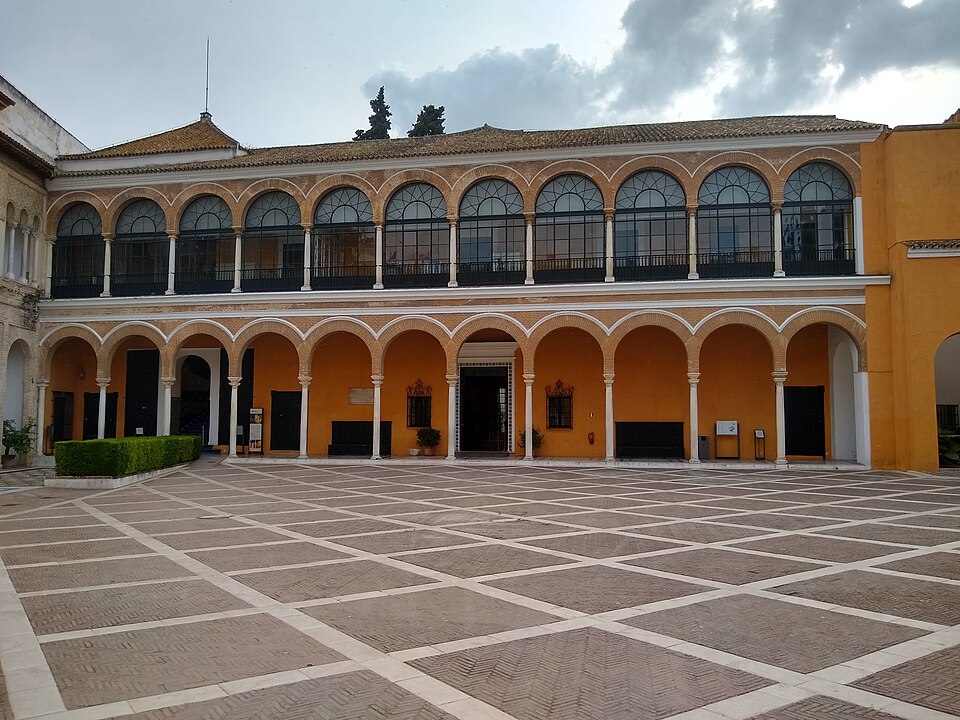OCR Specification focus:
‘Central and local administrative systems by Spain and Portugal.’
The central and local administrative systems established by Spain during the early modern period were designed to manage vast overseas territories, maintain imperial authority, and ensure the flow of wealth. These structures reveal both innovation and rigidity, as Spain attempted to govern distant colonies through bureaucratic mechanisms and loyal officials.
Central Administration in Spain
The Crown’s Authority
At the heart of Spanish imperial governance was the monarchy, which claimed sovereignty over all colonial territories. The Spanish monarchs, particularly Ferdinand and Isabella and later the Habsburg kings, viewed the empire as an extension of their divine authority.
The monarch exercised power through royal councils, particularly the Council of the Indies (established in 1524), which became the central administrative body for colonial affairs.
The Casa de Contratación (House of Trade), established in 1503 in Seville, controlled commerce, navigation, and emigration to the New World.
Council of the Indies: The supreme governing body for Spanish America, responsible for legislation, judicial appeals, and oversight of officials in the colonies.
The Council of the Indies allowed the monarchs to maintain control at a distance, drafting laws, reviewing reports from colonial governors, and ensuring that colonial revenues reached the Crown.
The Casa de Contratación
The Casa de Contratación played a crucial role in regulating trade and exploration.
It licensed all ships and merchants heading to the Americas.
It maintained maps, pilot training, and ensured that wealth (especially bullion) was shipped securely.
It collected taxes such as the quinto real (royal fifth), a 20% levy on all precious metals extracted in the Americas.
This institution symbolised the Crown’s determination to keep commerce tightly controlled, ensuring colonial resources were exploited for the benefit of Spain.
The Casa de Contratación (1503, Seville) regulated trade, registered ships and migrants, trained pilots and maintained the Padrón Real.

Photograph of rooms that formed part of the Casa de la Contratación in the Patio de la Montería, Alcázar of Seville. From here, royal officials coordinated fleets, licencing, and navigational standards for the Indies. This real-world setting supports your explanation of the Casa’s administrative reach. Source
From Seville, the Casa kept the Padrón Real (master chart), underpinning safe navigation and territorial claims.

This large, richly annotated world map (1529) by Diego Ribero exemplifies the Padrón Real maintained at Seville. It demonstrates how central cartography supported policy, navigation standards, and imperial oversight. Source
Local Administration in the Colonies
Viceroyalties
To govern territories across two continents, Spain created viceroyalties, each headed by a viceroy, who acted as the monarch’s representative.
The Viceroyalty of New Spain (established 1535) governed Mexico, Central America, and later the Philippines.
The Viceroyalty of Peru (established 1542) governed South America.
Viceroy: A royal governor appointed by the Spanish monarch to act as the king’s representative in a colony, responsible for administration, defence, and justice.
The Viceroyalty of Peru (established 1542) governed Spanish South America before later partitions.
Viceroys had broad authority but were monitored through regular reporting and the system of residencia (a judicial review of an official’s conduct at the end of their term).
Audiencias and Governors
Alongside the viceroys were audiencias, high courts of appeal that served both judicial and advisory roles.
Audiencias acted as a check on the viceroy’s power, ensuring laws were upheld.
Regional governors and captains-general managed smaller territories, especially frontier zones where military defence was essential.
The combination of viceroys, audiencias, and governors created a layered system of governance that mirrored Spain’s centralised monarchy.
Local Municipalities: Cabildos
At the most local level, Spanish towns and cities were administered by cabildos (town councils).
Members, initially elected but increasingly appointed, represented settlers and oversaw local order, taxation, and infrastructure.
Cabildos reflected the Spanish tradition of municipal self-government, but were gradually dominated by elites known as criollos (Spaniards born in the Americas).
This gave local elites a stake in governance while still keeping ultimate authority with the Crown.
The Church and Administration
Patronato Real
Religion was deeply tied to governance. Through the Patronato Real (Royal Patronage), the Pope granted Spanish monarchs the right to appoint bishops and control church revenues in the New World.
The Catholic Church became an instrument of imperial control, providing education, enforcing morality, and supporting conversion of indigenous peoples.
Bishops and archbishops often sat on the audiencias, giving the Church a formal role in governance.
Patronato Real: A system granting Spanish monarchs control over church appointments and finances in the colonies, ensuring religious and political authority worked together.
The Church’s dual role in spiritual and political administration reinforced Spanish authority, while also entrenching Catholicism as a cultural foundation in the Americas.
Mechanisms of Control
The System of Residencia
The residencia ensured that colonial officials could not rule unchecked. At the end of their tenure, officials were subject to inquiry into their conduct.
Testimonies were gathered from locals and fellow officials.
Malpractice could result in fines, imprisonment, or loss of titles.
This system highlighted Spain’s concern with corruption and the need to assert royal authority even across the Atlantic.
The System of Visitadores
Occasionally, the Crown dispatched visitadores (royal inspectors) to investigate specific abuses or failures in the colonies.
They had extraordinary powers to override local authorities.
Their reports often led to reforms or punishments.
These mechanisms emphasised Spain’s reliance on bureaucratic oversight to maintain imperial cohesion.
Limitations and Challenges
Despite the elaborate administrative system, Spain faced persistent challenges:
Distance and communication delays meant decisions from Spain could take months to reach the colonies.
Local officials often developed independent power bases, particularly in remote areas.
Corruption, smuggling, and conflict between civil and ecclesiastical authorities undermined effective governance.
The vastness of the territories made uniform administration impossible, requiring compromise and delegation.
Broader Impact
The Spanish administrative system in the Americas was pioneering in scale and complexity, representing one of the first attempts to govern a global empire through bureaucracy. It combined centralised royal control with local institutions, while also integrating religious authority. This structure provided stability, but it also planted the seeds of later tensions as colonial elites resented restrictions and the heavy oversight of the Crown.
FAQ
The Council of the Indies met regularly in Madrid and consisted of legal experts, administrators, and clerics. It reviewed reports (relaciones) sent from the colonies, drafted new laws, and advised the king on appointments.
Its daily tasks also included handling judicial appeals from overseas and overseeing financial accounts. This made it both a legislative and judicial body, ensuring that Spain’s overseas empire was run with constant reference back to the monarchy.
Officials of the Casa de Contratación were often skilled in navigation, law, or finance.
Pilots trained with the Casa used astronomical instruments and charts.
Clerks and administrators learned accountancy to track revenues.
Some officers were tasked with updating the Padrón Real, requiring expertise in cartography.
This training reflected the Casa’s dual role as both a commercial office and a scientific hub for exploration.
Audiencias were more than courts. They acted as advisory councils for viceroys and sometimes even checked their authority when disputes arose.
They could communicate directly with the Crown, bypassing local officials, which gave them an independent channel of influence. This dual role made audiencias crucial in balancing centralised authority with local realities in the colonies.
Although subordinate to the Crown, cabildos exercised significant influence at the town level.
They managed taxation for local works such as roads or water supply.
They oversaw policing and maintenance of order.
Cabildos could petition the Crown on behalf of their towns.
Over time, cabildos became dominated by local elites, giving American-born Spaniards (criollos) a growing role in colonial governance.
When an official completed their term, a judge was appointed to investigate their conduct.
Witnesses, including settlers and fellow officials, gave testimony.
Financial accounts were scrutinised to check for corruption or mismanagement.
Penalties ranged from fines to removal of titles.
This system discouraged abuse of power but also created delays and tensions, as some officials governed cautiously to avoid later censure.
Practice Questions
Question 1 (2 marks)
Name two central institutions established in Spain to administer its overseas empire.
Mark Scheme:
1 mark for each correct institution, up to a maximum of 2 marks.
Acceptable answers include:
The Council of the Indies
The Casa de Contratación (House of Trade)
Do not award marks for vague references such as “royal officials” or “the monarchy” without specifying a particular institution.
Question 2 (6 marks)
Explain how Spain maintained control over its overseas officials in the sixteenth century.
Mark Scheme:
Award up to 6 marks.
1–2 marks: Simple statements with limited explanation, e.g. “They had viceroys and governors who reported to the king.
3–4 marks: Some explanation showing understanding of control mechanisms, e.g. mention of the residencia (judicial review of officials) or the role of audiencias as checks on viceroys.
5–6 marks: Developed explanation covering multiple methods and showing clear understanding, e.g.:
Residencia inquiries at the end of an official’s term.
Visitadores (royal inspectors) sent to investigate abuses.
The role of audiencias in checking the power of viceroys.
Reports and correspondence sent to the Council of the Indies.
Maximum marks require detail and explanation of at least two methods, demonstrating how they helped maintain royal control.

